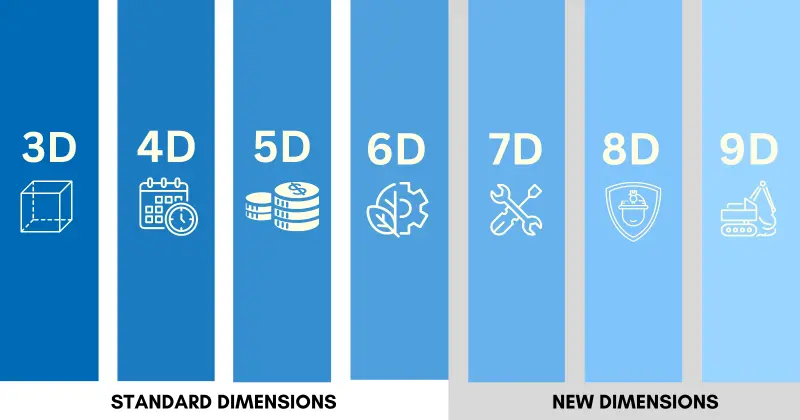10 mins read
Embedding Life Cycle Costing in 5D BIM

For this blog post, we have a guest post from Dr Dermot Kehily from Dublin Institute of Technology. Dermot recently had a paper published in the International Journal of Information Technology in Construction (ITCon) regarding research on LCC and BIM. The paper was a synopsis of his PhD research on utilizing 5D BIM (RIB CostX) for Life Cycle Costing. He has summarized the key findings of the paper below.
1. BIM AND LIFE CYCLE COSTING
Life Cycle Costing (LCC) is an area of Quantitative Surveying (QS) practice that concerns the calculation of both construction CAPital Expenditures (CAPex) and Operational Expenditures (OPEX). Despite the significant research in LCC in the last fifteen to twenty years, it has not been extensively implemented into QS practice. QSs require a means to carry out LCC effectively in accordance with the relevant standards and guidelines.
Building Information Modelling (BIM) offers capabilities that can aid QSs in increasing efficiency in their work practices. One of the primary benefits of BIM for QSs is that it can automate quantity takeoff (QTO) and free up time to concentrate on activities that would add further value for their clients. While LCC is identified as a value-enhancing service, there has been limited research on how BIM could be leveraged to increase efficiency in facilitating this service.
In the 5D BIM process, practitioners can move from spending time on generating quantity and cost information to validating the quantities and costs contained within their CAPex estimates. To carry out effective 5D BIM, QTO must be generated from the BIM to suit QS requirements and measurement rules. This process is defined as ‘model mapping’, where the objects in the model are attributed to a QS Work Breakdown Structure (WBS), so that when the quantities are extracted they are aligned to that code.
BIM authoring tools do not currently have the probabilistic capabilities to accommodate the variable conditions for LCC analysis. A more flexible structure than BIM can provide is needed for the probabilistic nature of LCC calculations and the many variables necessary for ‘what if’ analysis.
2. EMBEDDING LCC IN 5D BIM
In this research, an LCC calculation structure is incorporated into a 5D BIM platform. The research adopted RIB CostX 5D BIM software. CostX was selected because it has a ‘workbook’ similar to the functionality and capabilities of a spreadsheet, giving the user an opportunity to add new columns, rows, and functions that can link calculations between them. Furthermore, RIB CostX’s spreadsheet functionality can be utilized to replicate the LCC calculation structures proposed in LCC international methodologies and standards, which are based on spreadsheets.
Fig. 1 represents the summary page and the total line items for the three relevant sub-sheet calculations in the LCC calculation methodology proposed in this research. These three sub-sheets form the basis for any LCC calculations in an LCC estimate. In the example presented in Fig. 1, the summary structure is broken down per the WBS recommended in ISO 15686-5 for ‘Buildings and constructed assets; Service-life planning; Part 5: Life-cycle costing’. Clicking on the line of the relevant element (WBS) in the summary, the user is able to access the applicable sub-sheet and LCC calculations to build up LCC costs within that element.

- FIG. 1: Summary Sheet
The first sub-sheet (Fig. 2) deals with the calculation of full replacement cost items in an LCC estimate. User-defined LCC columns are added to the RIB CostX workbook (in this sub-sheet) to enable LCC calculations for major replacement items. The LCC cash flows throughout the analysis period and the total LCC costs (real, escalated and present value) are automatically calculated and populated from the LCC data requirements outlined in the calc sheet of the workbook (see full paper for details) and the replacement period and uplift factor entered in the LCC user defined columns in Fig. 2. The majority of cost plan items will also need an uplift factor, for preparation, demolition and making good to receive new work, over and above the basic installation cost. To enable the LCC calculations expounded in Fig. 2, ‘IF’ scenario formulae are embedded in each of the yearly cash flow cells for every line item. These formulae are similar to MS Excel functions and automate the calculation of cash flows by utilising ‘IF’ functions deriving data from the ‘Replace Period’ (column J), the ‘Uplift Factor’ (column K) and the data requirements. If any of these variables change the calculations, resultant cash flows and total LCCs (real, escalated and present value) will be updated. In this example, a ‘Present Value’ cash flow is generated for replacing the ‘910 x 2110 Internal door’ every 6 years within the 30 year analysis period, input in the data requirements (i.e. year 6,12,18,24,30). The ‘IF’ functions dictate that any year that is not a multiple of the ‘Replace Period’ will have a value of ‘0’. Cash flows for ‘Real’ and ‘Escalated’ costs are calculated in the same manner (albeit with different formulae), but are not included in this screenshot as the expanded scope would limit the clarity of the illustration. As demonstrated in Fig. 1, these LCC totals (columns L, M and N) and the accumulated cash flows carry forward to the relevant element on the summary sheet. The same sub-sheet can be used to represent the relevant ‘major maintenance and replacement costs’ for every applicable elemental category in the LCC estimate.

- FIG. 2: LCC Calculation Sub-Sheet [1]
- *Refer to full paper for details of subsheet 2 and 3.
3. FINDINGS
BIM makes it possible for consultants to expand the scope of their services by freeing up time in the laborious QTO process. Despite the benefits of LCC, it is a service that is not widely practiced by QSs due to a number of barriers that impede its implementation. While consultants are developing capabilities in BIM for QTO and CAPex estimating, there is an overall lack of enthusiasm utilizing BIM for LCC. This is not a product of QS’s lack of experience with BIM but rather their lack of knowledge of LCC and how BIM could be utilized to increase efficiency in providing this service.
Feedback from the participants in this study indicated that leveraging 5D BIM and incorporating a LCC calculation structure automates LCC, thereby making it easier and significantly quicker to carry it out. Participants noted that these calculations populate cash flows and cumulative LCC totals within a standard structure. Rooting the LCC calculations in a spreadsheet format was expressed as a benefit because it is the medium with which QSs are most familiar and, thus, expedites their learning curve.
The most prevalent theme that emerged from feedback from the participants is that this is a unique process enabled by an integrated 5D BIM based LCC technology (RIB CostX embedded with LCC calcs). Ultimately, CAPex and LCC reports can be generated from the same integrated system. The benefits of an integrated process give users the tools to interrogate the effect of different variables in both their CAPex and their OPex LCC estimates. Participants note that this advantage maintains transparency and links the workflows across the 5D BIM LCC process, providing efficiencies in quicker calculations and presentation.
The findings indicated that this process would make it easier and more likely that QSs would provide LCC services for their clients. All participants noted that they would use this system, if it were available to them. This study indicated that the direct benefits to the QS are:
- It can aid them in the calculation of tenders with an FM element such as PFIs;
- It can save outsourcing LCC to external consultants;
- CAPex and LCC can be incorporated in the same process;
- QSs can get more from their existing software without the expense of buying additional BIM LCC software.
- Rooting the LCC calculations in a spreadsheet; it is the medium in which QSs are most familiar with and thus, expedites their learning curve and facilitates trust in the process.
A number of participants commented on improving the integration between the BIM output and the LCC calculation structure. These recommendations propose that LCC data could be contained in the object properties of the authored model, which could then be utilized in the LCC calculations. This would essentially entail extracting LCC information from the model and linking it directly to the calculations in the LCC workbook. Existing practice is that this information comes from the QS’s database, but if, as a number of participants recommended, this information was included in the object properties of the design model, it would make it easier for QSs to access this information and provide further integration and automation in the 5D BIM LCC workflow. This could particularly have an effect on the access to LCC information barrier and speed up the production of LCC estimates by linking to data in the authored model.
To read the full paper, please click here.
If this insightful article sparked your interest in the powerful features included in our BIM takeoff software, get a free demo of RIB CostX today!

Most Recent
10 mins read
11 mins read
11 mins read
10 mins read
Blog Categories

Ebook










